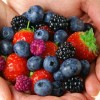 Fresh and frozen berries are popular foods. When berries are picked for fresh consumption, they are usually packed directly without washing because they are highly perishable. There is typically no “kill step” that would eliminate pathogens on fresh or frozen berries. Foodborne illness outbreaks have been associated with the consumption of fresh or frozen berries that were contaminated with pathogenic viruses, parasites, or bacteria. Contamination can occur before or during harvest or during final preparation. This 11-page fact sheet was written by Mary Palumbo, Linda J. Harris, and Michelle D. Danyluk, and published by the UF Department of Food Science and Human Nutrition, November 2014.
Fresh and frozen berries are popular foods. When berries are picked for fresh consumption, they are usually packed directly without washing because they are highly perishable. There is typically no “kill step” that would eliminate pathogens on fresh or frozen berries. Foodborne illness outbreaks have been associated with the consumption of fresh or frozen berries that were contaminated with pathogenic viruses, parasites, or bacteria. Contamination can occur before or during harvest or during final preparation. This 11-page fact sheet was written by Mary Palumbo, Linda J. Harris, and Michelle D. Danyluk, and published by the UF Department of Food Science and Human Nutrition, November 2014.
http://edis.ifas.ufl.edu/fs236
Category: Safety
The Food Safety Modernization Act of 2011 – Proposed Rule for Preventive Controls for Human Food
 The Food Safety Modernization Act (FSMA), which was signed into law by President Obama on January 4, 2011, is the most sweeping reform of food safety laws in more than 70 years since the enactment of the Federal Food, Drug and Cosmetic Act of 1938. High-profile foodborne outbreaks in the last decade and their impact on public health and the economy have exposed the need for a new, modern food safety system. FSMA aims to ensure the safety and security of the US food supply by focusing on preventing food safety problems rather than responding after they occur. This law provides the FDA with new enforcement authorities to achieve a higher rate of compliance with food safety standards and to respond better to problems. This 5-page fact sheet was written by Soohyoun Ahn, Keith R. Schneider, Michelle D. Danyluk, and Renee Goodrich-Schneider, and published by the UF Department of Food Science and Human Nutrition, April 2014.
The Food Safety Modernization Act (FSMA), which was signed into law by President Obama on January 4, 2011, is the most sweeping reform of food safety laws in more than 70 years since the enactment of the Federal Food, Drug and Cosmetic Act of 1938. High-profile foodborne outbreaks in the last decade and their impact on public health and the economy have exposed the need for a new, modern food safety system. FSMA aims to ensure the safety and security of the US food supply by focusing on preventing food safety problems rather than responding after they occur. This law provides the FDA with new enforcement authorities to achieve a higher rate of compliance with food safety standards and to respond better to problems. This 5-page fact sheet was written by Soohyoun Ahn, Keith R. Schneider, Michelle D. Danyluk, and Renee Goodrich-Schneider, and published by the UF Department of Food Science and Human Nutrition, April 2014.
http://edis.ifas.ufl.edu/fs248
There Is a Safety App for That! – Some Useful Agricultural Safety Apps
 An estimated 58 billion apps will be downloaded to smartphones and 14 billion to tablets in 2013. This 4-page fact sheet explores key features in smartphones and some available apps that can enhance the safety of agricultural operations. The apps presented represent a small fraction of the apps available on various platforms. Written by Michael T. Jensen, and published by the UF Department of Agricultural and Biological Engineering, August 2013.
An estimated 58 billion apps will be downloaded to smartphones and 14 billion to tablets in 2013. This 4-page fact sheet explores key features in smartphones and some available apps that can enhance the safety of agricultural operations. The apps presented represent a small fraction of the apps available on various platforms. Written by Michael T. Jensen, and published by the UF Department of Agricultural and Biological Engineering, August 2013.
http://edis.ifas.ufl.edu/ae498
Outbreaks of Foodborne Disease Associated with Fruit and Vegetable Juices, 1922 to 2010 (FSHN1204/FS188)
The FDA has recently mandated that all 100% fruit/vegetable juices sold wholesale be produced under a Hazard Analysis and Critical Control Point (HACCP) plan. As part of their HACCP plan, juice processors must identify and meet a target for reduction of the most resistant microorganism of public health significance that is likely to occur in the juice. This 7-page fact sheet aids juice processors in the identification of these “pertinent microorganisms,” and reviews the locations of juice preparations and severity of juice-associated outbreaks. Written by M. D. Danyluk, R. M. Goodrich-Schneider, K. R. Schneider, L. J. Harris, and R. W. Worobo, and published by the UF Department of Food Science and Human Nutrition, January 2012.
http://edis.ifas.ufl.edu/fs188
ENY141S/IN864 Cómo Lidiar con Abejas Africanas: Una Guía Práctica
ENY141S, a 4-page fact sheet by M. K. O’Malley, J. D. Ellis, Pablo Herrera and A. S. Neal, is the Spanish language version of ENY-141/IN739 What to do about African Honey Bees: A Consumer Guide. It provides information about Africanized honey bees (AHB), which have been labeled ”killer” bees, steps people can take to avoid negative interactions, how to handle stings, and bee-proofing basics. Published by the UF Department of Entomology and Nematology, August 2010.
http://edis.ifas.ufl.edu/in864
FSHN10-03/FS151 Food Safety on the Farm: Good Agricultural Practices and Good Handling Practices – Transportation
FSHN10-03, a 2-page fact sheet by Alexandra Chang, Alina Balaguero, Renée Goodrich-Schneider, and Keith R. Schneider, is part of the Food Safety on the Farm series and describes the best practices for transporting produce to avoid microbial infections, cross-contamination, and other possible hazards. Includes references. Published by the UF Department of Food Science and Human Nutrition, June 2010.
http://edis.ifas.ufl.edu/fs151
FSHN10-04/FS152 Food Safety on the Farm: Good Agricultural Practices and Good Handling Practices – Traceback
FSHN10-04, a 3-page fact sheet by Alexandra Chang, Alina Balaguero, Renée Goodrich-Schneider, and Keith R. Schneider, is part of the Food Safety on the Farm series and discusses the need for traceback requirements to identify and eliminate sources of microbial hazards, outbreaks, and food contamination. Includes references. Published by the UF Department of Food Science and Human Nutrition, June 2010.
http://edis.ifas.ufl.edu/fs152
FSHN10-02/FS150 Food Safety on the Farm: Good Agricultural Practices and Good Handling Practices—Manure and Municipal Biosolids
FSHN10-02, a 4-page fact sheet by Keith R. Schneider, Renée Goodrich-Schneider, and Alexandra Chang, is part of the Food Safety on the Farm series. It focuses on GAPs and GHPs relating specifically to manure and municipal biosolids. Includes references. Published by the UF Department of Food Science and Human Nutrition, May 2010.
http://edis.ifas.ufl.edu/fs150
FSHN06-2/FS136 Food Safety on the Farm: Good Agricultural Practices and Good Handling Practices—Water
Revised! FSHN06-2, a 5-page fact sheet by Keith R. Schneider, Renée Goodrich-Schneider, and Douglas L. Archer, is part of the Food Safety on the Farm series. It focuses on GAPs and GHPs relating specifically to water use. Includes references. Published by the UF Department of Food Science and Human Nutrition, April 2010.
http://edis.ifas.ufl.edu/fs136
PI227 EPA’s Endocrine Disruptor Screening Program (EDSP)
PI227, a 4-page fact sheet by F.M. Fishel, discusses EPA’s screening program for potential effects to the
endocrine system caused by pesticide exposure. Includes references. Published by the UF Department of Agronomy, April 2010.
http://edis.ifas.ufl.edu/pi227
ENY147S/IN863 Diferencias Entre Abejas Melíferas Europeas y Africanas
ENY-147S, a 3-page illustrated fact sheet by M. K. O’Malley, J. D. Ellis, C. M. Zettel Nalen and Pablo Herrera, is the Spanish language version of ENY147/IN784 Differences between European and African Honey Bees. It describes key differences between these two sub-species of Apis mellifera in their hive defense and stinging, swarming and absconding, and selection of nesting site. Includes references. Published by the UF Department of Entomology and Nematology, August 2010.
http://edis.ifas.ufl.edu/in863
PI28/PI061 Personal Protective Equipment for Handling Pesticides
Revised! PI-28, a 12-page illustrated fact sheet by Frederick Fishel, describes various articles of personal protective equipment (PPE) that are worn to protect the human body from contact with pesticides or pesticide residues. PPE includes such items as coveralls or protective suits, footwear, gloves, aprons, respirators, eyewear, and headgear. Includes references. Published by the UF Pesticide Information Office and Agronomy Department, July 2009.
http://edis.ifas.ufl.edu/PI061
FSHN0521/FS126 Agroterrorism in the U.S.: An Overview
Revised! FSHN-05-21, a 4-page fact sheet by R. Goodrich Schneider, K.R. Schneider, C.D. Webb, M. Hubbard, and D.L. Archer, discusses the use of biological agents in a deliberate, harmful attack, or terrorism using the weapons of biological warfare against the U.S. agricultural and food processing system. Includes references. Published by the UF Department of Food Science and Human Nutrition, April 2009.
http://edis.ifas.ufl.edu/FS126
ENY146/IN783 Living with African Bees in Florida’s Outdoor Workplaces
ENY-146, a 5-page illustrated fact sheet by M. K. O’Malley and J. D. Ellis, offers African honey bee related recommendations and precautions specific to outdoor workers in Florida. Includes references. Published by the UF Department of Entomology and Nematology, June 2008.
http://edis.ifas.ufl.edu/IN783
ABE214/OA125 Bloodborne Pathogens — OSHA Standard 1910.1030
Revised! ABE-214, a 17-page illustrated fact sheet by Carol J. Lehtola and Charles M. Brown, highlight the information and requirements in OSHA standard 1910.1030, which guides employers in providing for their workers safe and appropriate means for using needles and other devices for drawing and transferring blood and other similar materials. Includes references. Published by the UF Department of Agricultural and Biological Engineering, November 2008.
http://edis.ifas.ufl.edu/OA125
PI-168 /PI204 Safety Systems for Working with Pesticides
PI-168, a 3-page illustrated fact sheet by Frederick Fishel, provides a description of the following pesticide safety systems: closed mixing and loading systems, enclosed cabs, and containment
systems. Published by the UF Department of Agronomy, August 2008.
http://edis.ifas.ufl.edu/PI204
OSHA Standards Series
Revised! The following fact-sheets are condensations of Occupational Safety and Health Act (OSHA) Standards. They condense and highlight the information and requirements in the complete OSHA standards that all owners and managers of agricultural businesses should understand. Published by UF Department of Agricultural and Biological Engineering, September 2007.
ABE129/OA089 Temporary Labor Camps — OSHA Standard 1910.142
Carol J. Lehtola, Charles M. Brown, and William J. Becker
ABE183/OA078 Emergency Action Plans — OSHA Standard 1910.38
Carol J. Lehtola and Charles M. Brown
ABE194/OA095 Portable Fire Extinguishers — OSHA Standard 1910.157
Carol J. Lehtola, Charles M. Brown, and William J. Becker
ABE202/OA048 Powered Industrial Trucks — OSHA Standard 1910.178
Carol J. Lehtola, Charles M. Brown, and William J. Becker
ABE141/OA021 Occupational Noise Exposure: OSHA Standard 1910.95
Carol J. Lehtola, Charles M. Brown, and William J. Becker
ABE138/OA127 Portable Metal Ladders — OSHA Standard 1910.26
Carol J. Lehtola and Charles M. Brown
ABE128/OA086 Storage and Handling of Anhydrous Ammonia — OSHA Standard 1910.111
Carol J. Lehtola, Charles M. Brown, and William J. Becker
ABE182/OA077 Maintenance, Safeguards, and Operational Features for Exit Routes — OSHA Standard 1910.37
Carol J. Lehtola and Charles M. Brown
ABE126/OA067 General Housekeeping Requirements — OSHA Standard 1910.22
Carol J. Lehtola, Charles M. Brown, and William J. Becker
ABE127/OA068 Guarding Floor and Wall Openings and Holes — OSHA Standard 1910.23
Carol J. Lehtola, Charles M. Brown, and William J. Becker
PI-161/PI198 Transporting Pesticides and Understanding the Rules of the Road: Pest Control Businesses
PI-161, a 8-page illustrated fact sheet by Frederick M. Fishel, addresses the concern for transporting pesticides that are regarded as hazardous materials by the Secretary of Transportation. This document is specifically written to provide information for those who are in the pest control service industry. Published by the UF Department of Agronomy, January 2008. http://edis.ifas.ufl.edu/PI198
PI-160/PI197 Transporting Pesticides and Understanding the Rules of the Road: Farmers, Ranchers and Production Agricultural Operations
PI-160, a 5-page illustrated fact sheet by Frederick M. Fishel, addresses the concern for transporting pesticides that are regarded as hazardous materials by the Secretary of Transportation. This document is specifically written to provide information for those who are considered farmers by the Hazardous Materials Regulations (HMR). Published by the UF Department of Agronomy, January 2008. http://edis.ifas.ufl.edu/PI197
ENY-142/IN740 African Honey Bee Information for School Administrators
ENY-142, a 2-page fact sheet by M. K. O’Malley, J. D. Ellis and A. S. Neal, provides information about Africanized honey bees (AHB), precautions that can be taken on school grounds, an administrators checklist, and additional resources. Published by the UF Department of Entomology and Nematology, December 2007. http://edis.ifas.ufl.edu/IN740